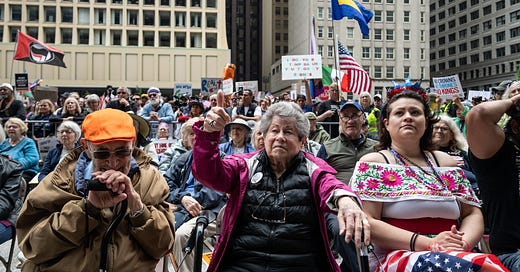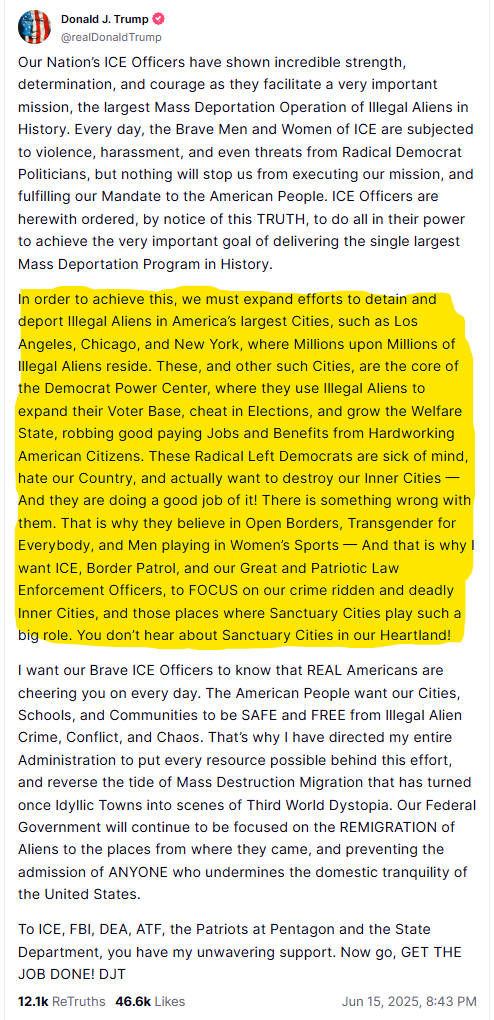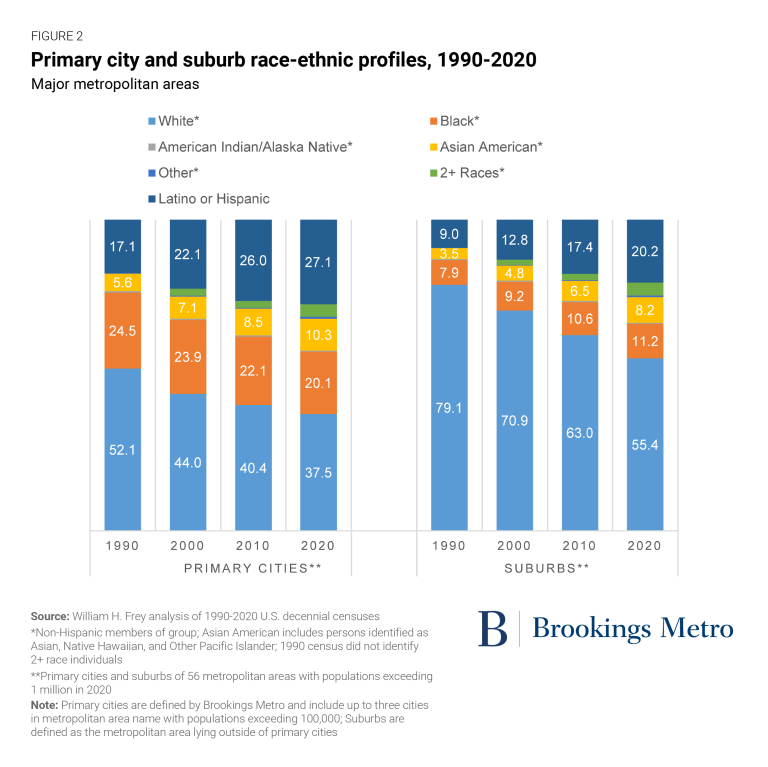When Trump Attacks Cities, He's Attacking America
Donald Trump hates America’s cities — and our suburbs, too.

President Trump has effectively declared war on America’s cities. This may not be much of a surprise given his history and the fact that he is always eager to find lines of division between Americans that he can widen, but it does demand some exploration if we are to understand what is happening right now.
Trump wants to cast this conflict he has created as one in which America is on one side and our cities are on the other. But here’s the truth: America’s cities are America.
Liberals are sometimes reluctant to say so, in part because they’re less attracted to mindless flag-waving than conservatives are, and in part because they may have internalized the relentless propaganda telling us that the true heart of our nation lies in dirt roads and fields of grain. But it’s time we shifted our view.
We begin with this statement from Trump over the weekend, announcing his order for law enforcement to descend on American cities:
The logic runs like this: Most undocumented immigrants are in cities (true); most cities are run by Democrats (true); cities are therefore the nexus of election fraud (false), the overuse of government benefits (false), and the theft of both benefits and jobs from real Americans (false); they are also “crime-ridden” (false) and the source of strange and threatening perversion (“Transgender for Everybody,” whatever that means). Therefore, Trump is justified in ordering a paramilitary (and at times military) assault on these cities. These operations, and the resistance they engender from the residents of those cities, will then be used to falsely claim that the cities have devolved into violent chaos and lawlessness, when in fact nearly all the violence is coming from law enforcement itself.
The justification for this assault is that cities and the people who live there “hate our Country” and are therefore not really part of our country at all. And of course, since it’s Trump this is very much about race. You’ll note his use of the anachronistic term “inner cities.” Geographically speaking, Central Park West is just as “inner” within Manhattan as 125th Street in Harlem, but the term refers to the latter and not the former, because it’s not about geography at all. He also claims that cities have become a “Third World Dystopia” as a contrast to the “Heartland.” There are plenty of communities in rural America that have suffered through crushing poverty and addiction crises, but no one refers to them as “Third World.” That’s an appellation Trump reserves for places with large numbers of people who aren’t white.
And it doesn’t come just from Trump; all the elements of this rhetoric are being reinforced by conservative media, which are telling their audiences every day that American cities are literally in flames, burning to the ground to feed liberals’ hatred of the true America. “They're burning their own cities just to prove to their bloodthirsty base that they're fighting Trump in the streets, burning their own cities for power,” says Fox News’ Jesse Waters.
Then at a Monday press conference at the G7 meeting in Canada, Trump invoked “Great Replacement” theory to justify his use of state violence against urban Americans:
“Biden allowed 21 million people to come into our country. Of that, vast numbers of those people were murderers, killers, people from gangs, people from jails, they emptied their jails out into the U.S. Most of those people are in the cities. All blue cities. All Democrat-run cities. And they think they’re going to use them to vote. Not gonna happen.”
The long migration
Anti-urbanism has been a feature of American discourse since even before the country became independent; Thomas Jefferson, who seldom missed an opportunity to express his contempt for all things urban, wrote that “The mobs of great cities add just so much to the support of pure government, as sores do to the strength of the human body.” People considered cities too loud, too dirty, too crowded, and too dangerous, and that was often true. But cities have also always been a wellspring of culture and innovation, which is part of what draws people there.
As a result, the story of this country is in many ways the story of steady urbanization. At the founding, most Americans were farmers and cities were relatively small; the cast of “Hamilton” may sing that the New York of 1776 was “the greatest city in the world,” but at the time its population was tiny, around 20-25,000. A hundred years later, the 1880 Census still classified over 70% of Americans as living in rural areas; 40 years after that, the 1920 census was the first in which the urban population outnumbered the rural population.
The migration from farm to city continued steadily in the ensuing years. Today, there are 346 American cities with over 100,000 residents; together they hold over 100 million of us. There are many ways to define what is urban and what is rural, but the Census still uses a binary classification; according to their system, the 2020 Census showed 80% of the country as urban and 20% as rural.
In their system, most of those who live in suburbs will be classified as “urban” because they live in metropolitan areas. But suburbs are defined by their proximity to the city, which is still the fuel that powers them and the reason people want to live there; without that, they’d just be isolated towns. Today, a majority of Americans describe the place where they live as suburban, but there has been an important change there too. Suburbs are getting more urban all the time. Which is something else Donald Trump can’t stand.
What do I mean by that? People who want to live in suburbs are increasingly looking for all the accoutrements of urban life, in greater quantity than suburbs used to feature. Yes, there’s still plenty of sprawl, but in today’s most dynamic suburbs you can find all the things people want out of the city: restaurants, entertainment, and communal public spaces, including active “downtowns” where people gather.
The evolution of the suburbs is happening all over the country, but let’s take just one example: Silver Spring, Maryland is a suburb just north of Washington, D.C., but if you go there it feels a lot like a small city. Between the 2010 and 2020 Census it grew from 71,000 residents to 81,000. It is absolutely bursting with new restaurants and retail, including from a fast-growing community of Ethiopian immigrants joining a place that is already one-quarter Latino, and its small skyline is dotted with cranes erecting new apartment buildings.
The same is true of the suburbs to the south of D.C. Virginia has turned from a purple to a blue state because of the rapid growth of the northern Virginia suburbs, driven by immigrant communities. In Fairfax County, for instance, over 20% of the population is Asian-American. Next door, Alexandria has gone from being a suburb to a genuine city in its own right, with a population of 159,000.
That’s a story that is repeated in suburbs outside large cities all across the country, one of growth and increasing racial and ethnic diversity. And just as the diversity of cities was always self-reinforcing, the diversity of suburbs is now too. When my great-grandparents came to America at the turn of the 20th century, it only made sense to go to New York; that’s where all the other Jews were. If you’re an Ethiopian immigrant coming here today, you can settle in a major city, but if you go to Silver Spring you’ll see a dozen Ethiopian restaurants and coffee shops, and know that this is a place you can feel comfortable. Put both internal and external migration together, and you have suburbs that have become dramatically less white over the last few decades:
For years, suburbs voted Republican; the people who fled cities for the white-picket-fence dream were mostly white and mostly conservative. But as suburbs have grown more diverse, their politics have changed, to the point where today suburbs are the main political battleground in America. Republicans own the rural areas, Democrats own the cities, and the suburbs are where elections are decided.
For Donald Trump, this is an emergency. In 2020 he started claiming that Democrats were coming to “destroy the suburbs”; it was part of his 2024 campaign as well. When he said that, it was affordable housing and racial diversity he was warning against. In other words, the horrifying future for the suburbs would be that they would come to look like the city. Which in many ways and in many places, they already have.
Cities are us
There are perfectly valid reasons one might want to live in a rural area or an exurb; everyone has their own conception of what constitutes a good place to live. But it’s important to keep pointing out that when Trump attacks cities, he’s attacking America. Los Angeles County, where the current controversy began, is home to almost 10 million people. That’s greater than the population of 40 of the 50 states; it exceeds the populations of Wyoming, Vermont, Alaska, North Dakota, South Dakota, Rhode Island, Delaware, Montana, Maine, and New Hampshire combined.
The story of the city is the story of America, of ambitious and energetic people coming to pursue their American dreams, banging up against each other, sometimes collaborating, sometimes in conflict, but always remaking themselves and the country again and again. Cities are messy and loud and complicated and innovative and dynamic, and so is America at its best.
Donald Trump should know that; his driving ambition for most of his life was to make it in Manhattan. Which also happens to be the place from which Fox News blasts its viewers every day with the message that our cities are hellholes, yet for some reason, the network hasn’t relocated its operations to rural North Dakota.
This ought to be a key part of the response to what Trump is doing: Yes, it’s authoritarian; yes, it’s unconstitutional; yes, it’s a betrayal of our ideals and our values. But it’s also an assault on the heart of America. Don’t be afraid to say it.
Thank you for reading The Cross Section. This site has no paywall, so I depend on the generosity of readers to sustain the work I present here. If you find what you read valuable and would like it to continue, consider becoming a paid subscriber.






What we who live in or near blue cities need to do it to respond to all of this bull with facts - the fact that blue cities in blue states, and blue cities in red states provide the economic engine that allows the red areas of blue states and the red areas of red states to survive as the parasites that they are. I feel much safer in NYC at 2AM than I do in any rural MAGA loving area at any time of day. Why? Because my chances of being shot by some hare brained MAGA with an AR-15 in Iowa is much higher than my chance of being shot by anyone in Manhattan or Brooklyn.
Outstanding clarity and analysis. As others have stated, he behaves like a domestic abuser: "if I can't have what/whom I want above all, I will crush you -- so no one can." He [apparently] could not have [the adulation of] Manhattan, nor [the adulation of] the overall US. So his drive is to crush Manhattan and the US. Chechnya? Ukraine...and more?